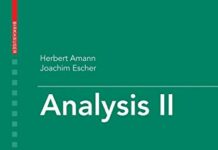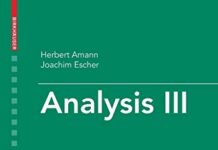
Ebook Info
- Published: 2005
- Number of pages: 441 pages
- Format: PDF
- File Size: 2.02 MB
- Authors: Herbert Amann
Description
“This textbook provides an outstanding introduction to analysis. It is distinguished by its high level of presentation and its focus on the essential.” (Zeitschrift für Analysis und ihre Anwendung 18, No. 4 – G. Berger, review of the first German edition)”One advantage of this presentation is that the power of the abstract concepts are convincingly demonstrated using concrete applications.” (W. Grölz, review of the first German edition)
User’s Reviews
Reviews from Amazon users which were colected at the time this book was published on the website:
⭐Amann’s and Escher’s Analysis Volume I, together with Volumes II and III, comprise an incredibly rich, comprehensive and self-contained treatment of elementary through advanced analysis. Beginning with set theory and a construction of the real numbers, the authors proceed lemma-by-lemma, theorem-by-theorem to the statement and proof of Stoke’s Theorem for manifolds in the last chapter of volume III.The authors’ typical style, as they admit in their preface, is to define mathematical objects and concepts in the most general possible way. They then work through the consequences of these definitions. To consider a specific example of this approach, the neighborhood definition of continuity is presented in III.1 where a function (defined between metric spaces) is continuous at x if for every neighborhood V of f(x) there exists a neighborhood U of x such that f(U) is contained in V. Subsequently, it is demonstrated that this is equivalent to both the traditional epsilon-delta definition and the case where continuity is defined in terms of convergent sequences. The authors also show that continuity so defined applies equally well to a normed vector space (since every normed vector space is also a metric space).This approach initially demands more of the reader and his capabilities of abstraction but, in the reviewer’s opinion, is the absolute best way to approach the subject. I’m really not sure what a true beginner in mathematics would think of it but the alternative is to define things repeatedly in increasingly general contexts as most analysis texts do.Basic concepts of topology such as connectedness, compactness and homeomorphisms are introduced early on to use as a foundation for proofs that would be far less elegant (and less direct) otherwise. For example, the Intermediate Value Theorem, is proved as a consequence of the connectivity of a space. Once this has been result has been worked out in generality, it is discussed in R.The derivative doesn’t appear until page 301 but, when it is introduced, it is defined in terms of what it actually is: a linear approximation. In most texts, this viewpoint isn’t discussed until “multivariable” analysis is covered.Overall, the proofs are concise and logical but do require some patience to follow. When making an argument, the authors frequently refer to lemmas a.b.c and theorems x.y.z without explicitly stating the principal they are using, even if it might have a name. Therefore, as a reader, you either have to be willing to follow the breadcrumbs they provide or make sure you see why their argument works. This really isn’t a criticism, just an observation. For this reason though, if you plan to buy volume N of their work, you must buy volume N – 1. In each volume, the authors concede in the preface that their is far too much material to be covered in one semester; indeed, there’s at least enough material in each volume for an academic year’s worth of work.
⭐Amann and Escher’s three volume collection is a clean, modern treatment of real and complex analysis. Translated into English, the three volume collection numbers over 1300 pages and constitutes a treatment of analysis that starts at the very beginning, with set theory and the Peano axioms, and eventually ends up at the elementary theory of holomorphic functions, Lebesgue integration and measure, and Stokes’ theorem on manifolds. There is easily enough material for a two semester undergraduate sequence on real and complex analysis and two first-year graduate-level courses on measure theory and integration and an introduction to smooth manifolds. The authors’ philosophy is that mathematical concepts should be introduced as a working 21st century mathematician sees them — in their fully modern, general, and abstract sense, rather than in the usual way which generally introduces definitions of increasing abstraction, based more-or-less on historical development. This aim is obviously shockingly unfeasible for all but maybe 0.01% of the math major population (or approximately 1 in 1 million of the general college student population) who have a natural capacity to understand abstract mathematics at an intuitive level and perhaps have an International Mathematical Olympiad medal or two to their name.For the rest of us, this textbook is good for someone who has already had a course at the level of Baby Rudin, Bartle’s Elments of Integration and Lebesgue Measure, or Spivak’s Calculus on Manifolds and wants to see a much more modern treatment of the same material and then some. The way the authors present the material is one-of-a-kind, and it is wonderful that this English translation is now available, but this is definitely *not* an introductory text in any sense.
⭐According to the back of the book, this book (and volume 2) are designed for an honors undergrad analysis class. This, however, is most definitely not the case. The book, especially volume 1, is quite basic: The first 150 pages are devoted to constructing the real numbers, and fundamentals (set theory, functions). The exercises aren’t too bad, and the style of writing is nice. In volume 1 there are a few typos, and in Volume 2 there are a lot of typos (check Tao’s UCLA page for an errata). My main complaint about the book is that Tao defines things his own way (which often differs from Rudin’s book and others), so it is a little tough to supplement with other books. Overall though the book is not bad, and worth a look ($30 bucks new is quite reasonable).
⭐This book (as well as the 2nd volume) comes out from the author’s lecture notes. It’s decent work but I would expect much more from a renowned mathematician.The book takes a very formal approach. It starts with building the number systems, from natural numbers to real numbers. The proofs are generally more detailed than similar text books. The chapters on Lebesgue integration are good. The author explains why the Lebesgue measure exists, instead of just presenting the definitions and theorems, like most introductory books do. The remarks dotted everywhere are instructive, reflecting the author’s broad knowledge in mathematics. No surprise, given Tao is one of the most versatile mathematicians in our time.The bottom line is it’s good but not exceptional. For introductory analysis book, I’ll still choose Rudin’s “Principles of Mathematical Analysis”. It covers more topics yet it’s more concise than these 2 volumes.
⭐Das Buch fällt beim Aufschlagen etwas auseinander…, leider. Aber es kommt ja auf den Inhalt an :-)Ungeachtet des Inhaltes der gedrucken Ausgabe bin ich von der Variante fuer den Kindle ueberwiegend enttaeuscht. Dies aus 2 Gruenden:1) Der Satz ist in Teilen ungenuegend, wiederholt sind Formelbloecke verstreut und damit kaum oder nur nach laengerer Rekonstruktion lesbar,2) Das Buch wird fuer den Kindle im AZW Format geliefert, ein Format mit digitaler Rechteverwaltung das ein Ausdrucken unmoeglich macht und fuer die Arbeit daher aeusserst unpraktisch ist.In der Summe waeren die 33 Euro deutlich besser in die Papierausgabe investiert.Eine kleine Aktualisierung; der auessert flinke und freundliche Amazon Kundenservice hat die Kaufsumme mittlerweile erstattet. Kudos!
⭐
Keywords
Free Download Analysis I 2005th Edition in PDF format
Analysis I 2005th Edition PDF Free Download
Download Analysis I 2005th Edition 2005 PDF Free
Analysis I 2005th Edition 2005 PDF Free Download
Download Analysis I 2005th Edition PDF
Free Download Ebook Analysis I 2005th Edition




